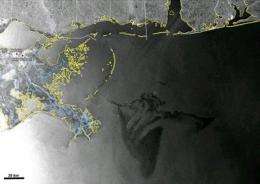BP to use domes to capture giant oil spill

Winds pushed a giant slick towards fragile wetlands on the United States coast Tuesday as efforts intensified to bottle up a ruptured oil well causing the growing environmental disaster.
Beleaguered energy giant BP said it had prepared the first of three giant domes to collect oil gushing into the Gulf of Mexico and channel it into a waiting tanker.
But a political tempest spread across the US, with California Governor Arnold Schwarzenegger backing away from a contentious proposal to drill for oil off the state's southern coast.
At least 210,000 gallons of crude a day has been streaming from a well below the Deepwater Horizon rig that sank on April 22, two days after a massive explosion that killed 11 workers.
A slick now covering the size of a small country has already touched Louisiana and is moving along the coast.
Shifting winds meant the oil could be pushed into a current that would take toward a wide area of the Florida coast, forecasters said.
"The magnitude of this spill is daunting," said Michael Sole, Florida's secretary of the Department of Environmental Protection.
Weekend storms grounded aerial sorties of dispersants and prevented skimming vessels from mopping up the growing 130-mile (200 kilometer) by 70-mile (110 kilometer) slick.
But an army of more than 2,500 responders and some 200 boats took advantage of better conditions Monday to lay out miles of protective booms, relaunch skimming vessels and train local fishermen for the clean-up effort.
"If we can get the seas to lay down for us we can make a dent," said Petty Officer Curtis Ainsley, leader of a coast guard team surveying the slick and installing mobile protective boom stations on boats.
"As soon as we can get the vessels here and the booms laid down we can get started skimming."
Florida Governor Charlie Crist added 13 more counties to the six already covered by a state of emergency.
The region boasts some 40 percent of US wetlands -- prime spawning waters for fish, shrimp and crabs and a major stop for migratory birds -- and cleaning up a maze of channels accessible only by boat would be all but impossible.
BP Chief Operating Officer Doug Suttles said the company had fashioned the first of three domes designed to be placed "over the leak sources and allow us to collect the oil, funnel it up through pipework to a drill ship called Enterprise on the surface."
He added that the company expects to load the fabricated containment chamber on Tuesday "and we hope to have the system up and operating within a week."
Efforts to contain the leak are costing more than six million dollars a day, the company said in a statement.
BP has been operating a fleet of robotic submarines in the murky depths for more than a week to try to activate a 450-tonne valve system that should have shut off the oil after the initial accident.
One has also been pumping dispersant directly into three leaks, but its impact on the amount of oil reaching the surface. was not immediately known.
BP began operations on a relief well Sunday, penetrating the sea floor as it began drilling down to approximately 18,000 feet so that special fluids and then cement can be injected to cap the oil.
With this process expected to take up to three months, attention is focusing on giant containment structures to be deployed to cover the leaking pipe a mile down on the seabed.
Suttles admitted there would be "technical challenges" in trying to sink a 65-tonne structure so deep, but added that physics was to some extent in BP's favor despite the extreme pressure.
With BP facing fierce criticism and political fallout from the disaster driving a new environmental debate, the disaster convinced California officials that a proposed drilling project off the Santa Barbara coast, northwest of Los Angeles, should not go ahead.
"It will not happen here in California," Schwarzenegger told a news conference.
(c) 2010 AFP



















